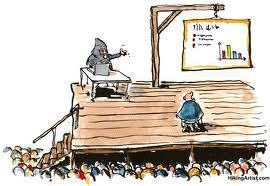Timothy Riesterer's Blog, page 29
November 5, 2012
The hobos were onto something
By Lisa Cummings, Corporate Visions
I recently visited a train museum with my nieces. Amidst the relics, a laminated guide to hobo communications stood out. Hobos – the migratory, homeless vagabond workers of the early 20th century – used a set of symbols to communicate with each other. The guide caught my eye because so many things in the museum seemed obsolete and inefficient. Yet this sign highlighted a language of visual communication. Without smartphones or PowerPoint – heck, they couldn’t even circulate written messages on paper – hobos developed a way to tell each other the often life-saving information of where to go to get work and how to avoid danger. The symbols were meaningful, memorable, and simple.

Two of my favorite symbols
Visual storytelling is not new. It’s what hieroglyphics were all about. Visuals have also exemplified many tribes and communities. Here’s a test. If you think of the hippie movement of the 60s and 70s, what pops into your mind? Peace signs, flowers, and maybe tie-died fabric, right? They’re all visual representations of a concept that would take a lot longer to describe with words alone.
Visuals bring clarity to words. Last year I went to France. I practiced my French enough to master short tourist conversations, but it was ultimately a picture that saved my life. What better way to communicate to any non-French speakers that they’re entering a room of high voltage danger? This picture was all I needed to stop me in my tracks.
The same concepts apply in business communications. Visuals or symbols and drawings can simplify concepts that seem complex in written form. And they can convey in a glance exactly what you’re trying to say. Imagine how much more powerful and memorable your stories would be to a prospect if you told them with a combination of words and pictures.
Want to learn more about how to communicate visually?
http://corporatevisions.com/whiteboard.html
Filed under: Business-to-Business, Deploy Tools that Get Used, Sales Tagged: communication, pictures, presentation skills, symbol, visuals

October 31, 2012
Trick or Treat? Are Your Customers Telling You the Truth?
 Imagine having untold amounts of valuable time and money to thoroughly question your customers about their pain points, their opinions on your products, their price points and desires for product improvements, and then building a product launch around the information they’ve given you. Ideal. Textbook. A sure thing. Right? Not necessarily.
Imagine having untold amounts of valuable time and money to thoroughly question your customers about their pain points, their opinions on your products, their price points and desires for product improvements, and then building a product launch around the information they’ve given you. Ideal. Textbook. A sure thing. Right? Not necessarily.
What customers say they’ll do and what customers actually do is a tricky thing. Research has shown that when there’s little risk involved, people imagine they’ll do all sorts of things that – when push comes to shove — they don’t end up doing. And that can be devastating to a business relying on customer insights.
Read Tim Riesterer’s recent article on MarketingProfs.com, “Voice of the Customer: Trick or Treat for your Product Launch,” to find out why the voice of the customer is not always trustworthy and how to actually get them to do what you want (buy your product or service!).
Filed under: Business-to-Business, Deliver Conversations that Win, Develop Messages that Matter, Distinct Point of View, Marketing, Sales, Your Buyer's Mind Tagged: create urgency to buy, customer conversation, messaging, pain, sales messaging

October 29, 2012
Enthralling Conversations, Meaningful Pictures: They’re Engaged!
The concept of “sales engagement” is all the rage. Experts are telling you to be more engaging with your prospects and customers. To some of you this sounds like a bunch of touchy-feely hogwash. It may even sound like a reason dating couples break up with each other: “He/she just wasn’t engaging enough for me…”
Before you get swept away in cynicism, stop for a moment. Think of all the PowerPoint-based presentations you’ve sat through during your career. What percentage of these dog and pony shows caused you to check out, or disengage from the presentation? Can you see how, if the presenter had created more engagement with you during those important moments, your interest might have held? That’s sales engagement.
 What do you think runs through your buyer’s mind when they see you open the laptop and fire up the projector? It’s probably similar to that moment at the dentist when you hear the whirr of the drill and your stomach starts to churn and you develop a low nervous sweat that says, “I hope they get this over with quickly.”
What do you think runs through your buyer’s mind when they see you open the laptop and fire up the projector? It’s probably similar to that moment at the dentist when you hear the whirr of the drill and your stomach starts to churn and you develop a low nervous sweat that says, “I hope they get this over with quickly.”
In the case of sales presentations, the result is low levels of engagement and the failure to communicate with the buyer, which end in either no second meeting 75 percent of the time (CSO Insights), or a no-decision outcome in 6 out of 10 forecasted opportunities (Sales Benchmark Index). According to Forrester, 88 percent of executive buyers prefer conversations to presentations. Maybe not so coincidently, Forrester also found that executives believe only about 12 percent of the sales calls they have participated in added value. Clearly there is a failure to engage and it is costly.
Convey Value, not Slides
Breaking away from traditional canned PowerPoint presentation to better converse with buyers is not as simple as it sounds. The “naturals” in your sales team have already figured this out, but what about the core group?
In a recent Sirius Decisions poll of sales managers in B2B companies, the #1 inhibitor to achieving quota was an inability to communicate value messages. It was not a lack of leads, weak skills, product complexity or lack of industry knowledge.
What we have learned is that salespeople cannot make up these value stories themselves; they need to have their message developed and delivered in a way that makes it sticky in the mind of the salesperson and memorable in the mind of the buyer.
Stories and Images bring your Capabilities to Life
Features and benefits are dead and buyers don’t care about them. They do care about the capabilities you give them that can help them solve their business problems. Getting these decision makers to picture themselves doing something different and better requires, well, pictures.
Without a story and imagery to help prospects visualize their new capabilities, see the contrast with what they are doing today, and imagine the difference it will make in the future, your presentations will fall flat…like yesterday’s open can of Bud Light in the fridge.
Recent discoveries in brain science have uncovered the nature of cognition. While PowerPoint slides packed with data, photography, drawings and bullets appeal to the logical and analytical neo-cortex (new brain), the old brain or “lizard-brain,” as Seth Godin calls it, is where our survival instincts are triggered and new decisions to change get made.
Appealing to the old brain to wake it up — giving it concrete and simple reason to cause it do something different — requires visualization with simple, whole images with contrast, which give a clear picture as to why its unsafe to stick with the status quo, along with presenting a clear reason to move to the safety of the new.
Whiteboard imagery embodies the simplicity of ancient communications to convey powerful meaning to the old brain. That coupled with a great story with contrast is an order of magnitude more persuasive than PowerPoint using metaphorical or borrowed interest photography.
If you need help translating your old presentation deck into a whiteboard that brings your story to life, we should talk. With more than 500 whiteboards, under out belt, we’ve learned a thing or two about what it takes to create sales engagement.
Filed under: Business-to-Business, Deliver Conversations that Win, Develop Messages that Matter, Message Creation, Sales Tagged: communicating value, create urgency to buy, customer conversation, power point, tim riesterer

October 22, 2012
Killing them Softly with PowerPoint? Wake them up with Whiteboarding!
 We’ve all heard the term “death by PowerPoint,” or worse, experienced it. It refers to the lack of interactivity and boredom engendered by the typical slide presentation. The term invokes an arresting image that reminds us that, if you want to engage your audience while standing out from your competitors, slides aren’t the answer.
We’ve all heard the term “death by PowerPoint,” or worse, experienced it. It refers to the lack of interactivity and boredom engendered by the typical slide presentation. The term invokes an arresting image that reminds us that, if you want to engage your audience while standing out from your competitors, slides aren’t the answer.
In this post, we’ll look at five ways salespeople can boost performance using “visual storytelling” instead of slides. Whether using a whiteboard, a flip chart, the back of an envelope or a tablet PC via desktop sharing software, you can integrate the visual storytelling model into your existing sales methodology and apply the approach as a powerful differentiator in competitive and complex selling environments.
Five Ways to Tell Your Story Visually
1. Develop a Powerful Whiteboard “Story” Instead of Bullet Points
Your presentation should be much more than just a list of bullets – it should be a compelling visual narrative designed to showcase your products and services and how they deliver unique value. For example, you could create a story about a tragic hero (an anonymous customer) who overcomes adversity (the current situation) to attain ultimate glory (the desired state, achieved uniquely by your solution/service).
The story also needs to be visually intriguing, with humorous iconography, and should have a script that goes along with each step. The whiteboard story should include planned “interaction points” where you’ll engage with the customer to ensure a two-way dialogue. Stay away from features and benefits. Instead, ask and help answer these specific questions: what’s the impact of sticking with the status quo, and what’s the value of making a change?
2. Stick Figures are More Powerful than Photography
One way people have attempted to fix the PowerPoint problem is by using large photographs and metaphorical imagery with just a few words on the slides. While this may help make a keynote speech more interesting, it doesn’t advance the cause in a sales cycle, make abstract ideas more concrete, or make complex concepts simpler.
Stick figures and symbols get it done – boxes, circles, arrows, dollar signs…stuff you can draw. Even more importantly, these hand-drawn visuals can be redrawn by your prospects after you leave the room. You want your story to “walk the halls” in your absence, right? You want your prospect to feel smarter and more empowered to promote your story? Well then, give them the gift of a simple story and visual that helps them understand and react, as well as own and distribute.
3. Visual Storytellers are More Consultative
With the visual storytelling approach, it’s essential that you immerse yourself in the content. Prospects perceive salespeople with a clicker in their hand as “PowerPoint jockeys.” You are telling a story that someone else created. A visual story that you draw, and explain along the way, gives you the credibility. It confers the knowledge and expertise to you, not the marketing department that created the pretty slides.
In a world where every salesperson wants to appear as a trusted advisor or practice consultative selling, visual storytellers are seen as adding more value, facilitating more engagement, and delivering insight and expertise. Storytellers get the room to think about their challenges and opportunities in a fresh and interactive way. Turning on the lights and taking a pen in your hand, as opposed to closing the shades and standing in the shadows of the LCD panel, create an entirely different perception of you and the role you are playing in the room.
4. Create a Sticky Virtual Experience
If you’re part of an inside sales team, or spend much of your sales cycle dealing with prospects over the Web and on the phone, visual storytelling can create a huge point of differentiation. Just because you aren’t face-to-face with the customer doesn’t mean you can’t use whiteboarding techniques.
Using simple Web conferencing software and an inexpensive pen tablet, you can easily simulate a full whiteboarding experience. This can be the difference between creating a remarkable and memorable sales experience, and sounding and looking like everyone else.
We’ve found that while 50 percent of WebEx viewers intermittently leave a remotely shared PowerPoint presentation to access other applications, the attrition rate is less than 10 percent using the visual storytelling approach.
5. A Whiteboarding Methodology
Great visual stories don’t happen spontaneously. They are pre-built based on the different moments of truth in the customer buying cycle. At the beginning, you need to answer the foremost question in the prospect’s mind: why should I change? You need a whiteboard that helps them see why their status quo isn’t safe and why they need to consider doing something different.
The next question you need to answer is: why you? For that you need a visual story that clearly delineates your differences and strengths in contrast to the status quo and the competitive alternatives. Finally, you need to address the question: why now? That calls for a visual story that presents the business case and a relevant example of how someone achieved their desired outcomes and realized the projected value.
Each of these is a different, complementary whiteboard that builds on the previous one and develops your story along the decision-making path.
The Reality
Having a good sales process is important, but having something truly provocative to say when you actually interact is essential. Visual storytelling is the fuel that powers your sales process engine.
Filed under: Business-to-Business, Deliver Conversations that Win, Sales Tagged: death by PowerPoint, PowerPoint, presentation skills, sales, visual storytelling, whiteboarding

October 17, 2012
The Five Biggest Messaging Myths
Breaking the status quo and taking your Marketing and Sales efforts to the next level requires challenging some long-held, favored messaging mantras. Are you being held back by any of these five false assumptions?
1. Personas are the best tool for developing effective messaging
2. Voice of the customer research is essential to any message development effort
3. 20-question discovery is the best way to start a new sales cycle
4. Zen presentation techniques are a must-have
5. You can’t make a difference in a big organization
Watch Tim Riesterer, co-author of the best-selling book Conversations that Win the Complex Sale, tackle each of these outdated ideas at the 2012 Marketing and Sales Messaging Conference… Mythbusters style.
Tim Riesterer – Mythbusters from Corporate Visions Inc on Vimeo.
Want more? Check out more videos from the Marketing and Sales Messaging Conference here.
Filed under: Business-to-Business, Deliver Conversations that Win, Deploy Tools that Get Used, Develop Messages that Matter, Marketing Tagged: Messaging Myths, Mythbusters, tim riesterer

October 15, 2012
The Elevator Pitch is Out of Order
Six years ago we blogged about how to differentiate yourself with your elevator pitch, in the unlikely scenario that you’re sharing a 22-floor elevator ride with a potential prospect. And in the last six years, you – like every other marketing and salesperson – have probably spent a lot of time and resources trying to perfect that pitch.
Here’s the problem. You’ve been toiling away perfecting a feel-good summary that tells YOUR story, not your audience’s. It’s what makes everyone proud to work for your company. It’s filled with lofty ideals, big words and corporate platitudes that look great on a banner in the cafeteria, but quickly decompress and fizzle to nothing when you get to the one-on-one customer conversation.
You need to translate your messaging in a way that is relevant to your prospect’s story. The conversation should hit on the following points:
The challenges your customers face;
The risks these challenges pose for their desired outcomes;
And how your capabilities uniquely solve these problems.
Let’s imagine how this might play out. You’re at an industry event when you spot Joe Car Man. The company name and title on the badge makes you quiver with excitement, as you are Jane Brake Woman. You sidle up, introduce yourself and casually say, “GoFast Cars, huh? I’ve heard that sports-car makers have started moving into your market because of your customers’ interest in race-car caliber safety features.” He pauses, mid-sip and nods. “Must be tough for you to compete, as adding race-car safety standards, such as big rotor brakes, is potentially cost-prohibitive for you.” He looks mildly impressed and smiles slightly. “We’ve started making brakes based on big rotor technology that have the same response time but are much cheaper for our car manufacturer customers.” He puts down his drink, motions toward a chair and asks you to sit down and tell him more.
This is clearly blind meeting nirvana, but the approach is much more compelling and engaging than spewing out the value, features, benefits that you’ve memorized as your elevator pitch. Offering a distinct point of view that helps your customers see why they can no longer stay in their status quo will not only grab their attention, but might also get them to care enough to hear the rest of your story.
Filed under: Business-to-Business, Deliver Conversations that Win, Develop Messages that Matter, Distinct Point of View, Focus on the Buyer, Focus on your Prospect, Message Creation, Uncatergorized, Your Buyer's Mind Tagged: customer conversation, elevator pitch, memorable, uniqueness, Your Buyer's Mind

October 9, 2012
Marketing’s Job Doesn’t Stop at “Sales Accepted”
 Congratulations, marketer! You’ve generated qualified leads by the dozen that you’re handing over to sales for follow up. Your job is done, right? Not even close.
Congratulations, marketer! You’ve generated qualified leads by the dozen that you’re handing over to sales for follow up. Your job is done, right? Not even close.
SiriusDecisions, a leading marketing and sales effectiveness analyst firm, recently published a blog post called, “Sales Accepted Leads: The Most Important (and Most Overlooked) Step in the Demand Creation Process.”In the post, they encourage using a “marketing qualified” to “sales accepted” status change to ensure qualified leads don’t end up lost in oblivion.
Great and necessary step, but your work doesn’t end there. Perhaps you’ve set up various triggers to remind sales that they’ve got a hot lead and time’s a wastin’, but beyond that, most marketers essentially abandon the revenue generation process – even though it’s the marketing messaging that grabbed the prospect’s attention in the first place.
Here are three steps for adding value after a lead is qualified and in the sales person’s hands:
Get your messages in a row.
If a prospect has been visiting your website and clicking on and downloading content relating to challenge A, you don’t want your sales rep following up with a message focused on challenge B. Make sure your sales rep can easily see, within the lead management system, which message the prospect responded to. Once that’s established…
Equip your reps with follow-up tools that align to that message.
Don’t stop creating compelling content. Every marketing message needs to be backed with a corresponding sales talk track. Equip reps with a call-guide document that provides quick-hitting, additional pieces of insight into the challenge each campaign highlights. Don’t spell out the entire call for them (no good rep reads from a script) – but give them provocative industry facts, grabbers and key points to bring to the conversation. Otherwise, the “follow-up” turns into one email saying, “Hi, I left you a voicemail. Are you interested? When are you available to talk?” (You think we’re joking, but we’ve seen those emails come through. You know who you are.)
Track conversion rates by rep.
In any given month, track how many leads went from sales accepted to sales qualified (the lead is now in the pipeline), broken down by rep. Reps that are showing lower-than-average conversion rates likely need additional messaging coaching to increase their follow-up effectiveness.
Filed under: Business-to-Business, Deliver Conversations that Win, Deploy Tools that Get Used, Marketing, Sales, Sales and Marketing Alignment, Sales Readiness Tagged: marketing, sales, sales tips, sales training

October 3, 2012
Survey Finds 1 in 3 Sales and Marketers Do Not Collaborate to Develop Messages
 We recently polled more than 730 business‐to‐business (B2B) sales and marketing professionals worldwide. The findings highlight the lack of collaboration between the sales and marketing teams of industry-leading companies as they work to differentiate their solutions in today’s marketplace. In fact, a staggering one in three respondents reported that their message creation process is non-collaborative, politically charged or nonexistent. To delve deeper into the issue of marketing and sales alignment, and determine exactly where the disconnect between teams is occurring, Corporate Visions posed survey questions about messaging, content and tools development within organizations.
We recently polled more than 730 business‐to‐business (B2B) sales and marketing professionals worldwide. The findings highlight the lack of collaboration between the sales and marketing teams of industry-leading companies as they work to differentiate their solutions in today’s marketplace. In fact, a staggering one in three respondents reported that their message creation process is non-collaborative, politically charged or nonexistent. To delve deeper into the issue of marketing and sales alignment, and determine exactly where the disconnect between teams is occurring, Corporate Visions posed survey questions about messaging, content and tools development within organizations.
Notable findings from the Q3 survey include:
Message creation process is non-collaborative – The responses revealed that one-third of respondents’ companies have a collaborative process for creating messages that involves both the sales and marketing teams; one-third have a process that is non‐collaborative, politically charged or nonexistent; and one-third have a process that is semi-collaborative. This means a whopping two-thirds of the companies represented in the survey are struggling to achieve a truly collaborative process for message development. By operating in distinct silos, marketing runs the risk of creating messages that will fail to effectively reach customers, and by extension, that salespeople are not comfortable delivering or will not use.
Field sales representatives are left out ─ Respondents indicated that, of the professionals involved in messaging/tool creation, field sales representatives constitute only 37 percent of the room, compared to marketing associates, which represented 54 percent. Because field sales representatives are essential to ensuring that relevant messages are delivered to customers, these statistics – which indicate that they are rarely involved in the creation process – are alarming.
Messaging and sales tools are created by accident ─ A meager three percent of respondents said their company uses a repeatable process when creating content, messages and tools across the enterprise. The implications of these results are that most messaging and tools created to support sales teams are done more by accident than on purpose, and enterprises are risking inconsistent and diluted messages.
“The results of this quarter’s survey indicate that while some organizations are taking steps to better align sales and marketing, many continue to operate in inefficient silos,” said Tim Riesterer, chief strategy and marketing officer, Corporate Visions. “Enterprises need to employ a cross‐functional framework for message development where marketing and sales work together to create messaging that resonates with customers. The repeatable framework should begin with identifying the customer’s main goals, then pinpoint how these goals are at risk.
These risks will redefine the customer’s needs that only your solution/service can meet, which in turn will help you create new, effective messages and tools for any campaign.”
For more details on the survey findings, watch this short video or download the infographic.
Filed under: Business-to-Business, Develop Messages that Matter, Message Creation Tagged: collateral, content, marketing and sales messaging report

October 1, 2012
The Power of Video
Picture this:
Close up of ocean waves washing over rocks. Howard Shore’s “Lord of the Rings” score wafting in the background. Fade to laundry hanging on clothesline, seagull flying over house perched on cliff. Fade to fishing boat, man petting dog nearby. Fade to family photo, voiceover: “You will give the people an idea to strive toward.” Fade to boy running through field, hint of red cape trailing behind. Fade to hitchhiker on a mountain road. Fade to birds-eye view of a farm field. Voiceover: “In time, they will join you in the sun.” Fade to butterfly on chain. Voiceover: “In time, you will help them accomplish wonders.” Fade to boy with red cape. Fade to text, “Man of Steel.” Fade to caped man flying at mach-speed through the clouds.
Most of you probably started skimming by the third line of that paragraph. Ninety percent of you didn’t make it to the end. We’re lucky if you’re even reading this.
We’ve just described a trailer for the yet-to-be-released Superman movie. Now watch this…
[image error]
That’s the power of video. Stimulate the senses and the decision-making part of the brain by using video or visual storytelling in your marketing content.
Learn more…
Thanks to Corporate Visions Global Accounts Manager Ted Ergo for the idea for this post.
Filed under: Business-to-Business, Deliver Conversations that Win Tagged: customer conversation, grabber, presentation skills, sales messaging

September 24, 2012
What I Learned from “Breaking the Status Quo Barrier”
By Rebecca Blouin, Davies Murphy Group
I spent last Wednesday and Thursday live blogging from Corporate Visions’ Marketing and Sales Messaging Conference, “Break the Status Quo Barrier” in Chicago. Perched on the ballroom balcony with my fellow blogger, high above the heads of the 400 attendees, we looked much like “The Muppet Show’s” Statler and Waldorf, gazing down with a critical eye and plenty to say (but considerably better groomed hair). After 17 presentations, two bran muffins eaten hastily at the start of every morning, and dinner with a tarpon, these are the things that have stuck with me.
Never judge a conductor by his cover.
Though deep down I trusted the wisdom of Corporate Visions’ conference organizers, I couldn’t imagine how Ben Zander, the conductor of the Boston Philharmonic Orchestra, could possibly keep the attention of senior-level marketing and salespeople for two entire hours. Does a conductor a good speaker make?
Yes. That conductor made a phenomenal speaker. I don’t exaggerate when I say that Ben was one of the best – if not the best – speakers I have ever seen. And I can safely state that from the standing ovation, shining eyes, and line of people waiting to have their Ben Zander books autographed, the attendees agree.
Ben demonstrated to me that you don’t need a presentation, notes or even a stage to thoroughly engross an audience. Your message can be powerfully delivered with two white boards, a few pens, a piano (optional), and some thoughtful, gripping stories. And a good dose of humor and fiery passion for what you do is also helpful.
Getting marketing and sales to work in sync is “wicked hard.”*
*Courtesy of Kevin Joyce, chief sales and marketing officer, Miranda Technologies
Nineteen of the best and brightest leaders in marketing and sales regaled us with case studies, stories, overviews and anecdotes about their struggles with unifying marketing and sales around a consistent set of effective messages and materials. One of their main messages? It’s really hard work. Their ultimate message? With hard work, a partner and a plan, it’s entirely possible and will pay dividends in the end.
Self-deprecation can be charming in a presentation.
I can imagine that when you’ve reached the pinnacle of corporate success – be it a senior-most position or founding a profitable company – it might be difficult to resist the glow of success from leading you into pontification and self-congratulation. But to a person, the presenters laid bare their struggles and lessons learned and flew their geek flags proudly (Tim Riesterer in particular) to make their points and tell their stories to help others. That style is not only in line with Corporate Visions’ it’s-all-about-you-not-me approach, but it’s also very effective.
And no one embodied this as much as Billy Beane. With a bestselling book and award-winning movie based on your life, it would be easy to swagger like John Travolta in white polyester. But Billy humbly – and humorously – relayed the decisions he made to get where he is and praised the people who helped him get there. His self-deprecation had even the non-baseball lovers eating out of the palm of his (I probably high-fived Brad Pitt with this) hand.
Breaking the status quo takes a lot of chutzpah.
Inevitably when you take the road less traveled by, there are going to be naysayers pointing out the recklessness of that decision. What impressed me most about these market leaders was how they boldly defined a path, put a stake in the ground and heard – but didn’t listen to – the people who told them they were headed the wrong way. Several of the presentations included a story with the words “it was at this point we knew we were all-in.”
Billy Beane might have said it best with the quote he said served as a mantra for him and his team as they tried to redefine how to create a winning baseball team.
“The road to truth is long, and lined the entire way with annoying bastards.” Alexander Jablokov
Though fun for a picture, putting your arm around a cardboard cutout Brad Pitt is not as good as the real thing.
Or so I imagine…
Filed under: Business-to-Business Tagged: marketing, Marketing and Sales Messaging Conference, presentation skills, sales tips, tim riesterer

Timothy Riesterer's Blog
- Timothy Riesterer's profile
- 3 followers








